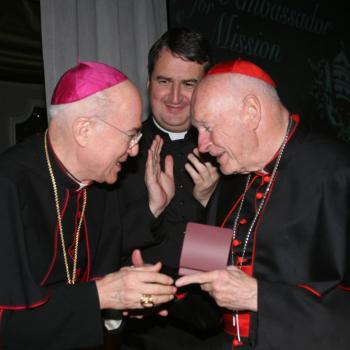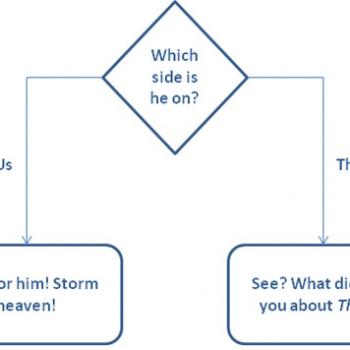This is a really good article by somebody who has figured the core falsehood at the bottom of the wrong-headed Conservative Catholic “reform” of the Church: that the problem is gays and liberals and if we can just purge them then the Church will be right as rain again. It’s just not true. The problem is abusers, gay and straight, and enablers, liberal and conservative. As long as at that falsehood continues to drive the pigheadedly unlearning Conservative–steadfast in his self-righteousness and unwilling to consider any opinion but his own–we will continue to fail. Check it out:
Ten years ago, I believed a myth. In the beginning, there was Vatican II. It was good but messy, and the Bad Catholics hijacked it to undermine doctrine. They took over seminaries and turned them into cesspools where heresy was mandatory and depravity rampant. Then Pope John Paul II came along. He drove out the Bad Catholics and cleaned up the seminaries. Too late! The Bad Catholics had already committed terrible crimes, which were covered up without the pope’s awareness. In 2002, their abuses exploded into public view, and the JPII Catholics got blamed for crimes committed by a dying generation of clerics. The JPII bishops took it on the chin, but they fixed the problem with the Dallas Charter. Then Benedict XVI, the great theologian, appointed orthodox bishops who would carry forward the renewal. The horrors of the Scandal were behind us. The two primordial forces of the postconciliar church, orthodoxy and heresy, had fought a great battle, and orthodoxy had been vindicated.
My diocese, the Archdiocese of Saint Paul and Minneapolis, was proof. In the 1980s, we were led by Archbishop John Roach. Appointed by Pope Paul VI, Roach fit the “Spirit of Vatican II” archetype to a tee. Under Roach, Saint Paul Seminary was taken over by dissenters, one of whom described the Eucharist as “cookie worship” that he had “moved beyond.” There were open homosexual affairs. Those who dared adhere to church teaching were punished.
Saint Paul soon experienced one of the first abuse scandals in the American church. For years, Roach and his cronies had secretly shuffled abusive priests between parishes. When this came out and the diocese was sued, Roach found himself under oath, where he became conveniently forgetful. The diocese lost, with the victim awarded $3.5 million—paltry by today’s standards, but shocking at the time. In response, Roach imposed “tough policies,” which won praise from newspapers. Privately, he declined to enforce them.
Finally, in 1995, Roach retired. John Paul the Great—as we called him—appointed Archbishop Harry Flynn. Flynn was a kindly Irishman with an adorable accent. He came from the Diocese of Lafayette, where he’d handled another early abuse scandal. He’d healed the victims of Lafayette, and he’d largely written the USCCB’s new abuse policy.Flynn was a JPII man. He loved prayer and took strong stands. He turned the feeble St. John Vianney College Seminary into the biggest minor seminary in the country. After Archbishop Flynn’s arrival, the sex-abuse story finally faded from the headlines. We were so proud when Flynn led the American church in drafting the Dallas Charter.
In 2008, Pope Benedict appointed Archbishop John Nienstedt, an orthodox leader who led the campaign against redefining marriage in Minnesota. While much of the country was roiling from Boston and its aftershocks, we enjoyed a palpable sense of peace. The Good Catholics had saved Vatican II from the Bad Catholics, and our Charter would keep it from happening again.
I know there are good priests. There may even be good bishops. But don’t trust your instincts.Our myth—their lie—collapsed in 2013. Archbishop Flynn was no healer, we learned. He was the USCCB’s damage-control guy. In 1986, Flynn went to Lafayette and killed the bad publicity. He said he’d visited all the families of the abused there. He hadn’t. He said he’d got the abusers out of ministry. He hadn’t. He got the media to think he had, but focused on getting the records sealed by court order. The scandal went quiet—but it was the quiet of a muzzle, not of healing.
When Flynn came to Minnesota, he did the same. We pew-sitters were led to believe the scandal ended here because Flynn’s policies solved the problem. In fact, it ended because Flynn’s legal team convinced a court that Minnesota’s statute of limitations on sex crimes barred most lawsuits. Flynn drafted the Dallas Charter, but he never bothered much with following it. In 2004, the diocese found pornographic images on Fr. Jonathan Shelley’s computer. To some, it seemed to be child porn; others considered it only “borderline illegal.” The borderline caucus won, and Flynn kept Shelley in ministry. That same year, Fr. Daniel Conlin provided marriage counseling to two of his parishioners, then fathered a child with the wife. Flynn removed Conlin from the parish…and transferred him to the marriage tribunal, where he came into contact with more vulnerable women. All of this and more was covered up.
Archbishop Nienstedt mostly continued the lax practices of his predecessors. While more proactive than Flynn, Nienstedt still fell far short of church policy and law. Nienstedt made one excellent choice: he appointed Chancellor Jennifer Haselberger, a canonist devoted to interpreting ecclesial law as written—not bending it to favor Roman collars. When Haselberger rediscovered Fr. Shelley’s “borderline illegal” porn in 2011 and showed Nienstedt, chancery officials spent more than a year debating what to do, instead of just calling the police. As similar cases mounted, Haselberger resigned and blew the whistle.
Our beloved myth exploded. Twin Cities Catholics like me came face-to-face with an unpleasant fact: the orthodox Good Clerics hadn’t taken over from the Bad “Spirit of Vatican II” Clerics and cleaned house. The Good Clerics were buddies with the Bad Clerics. They did everything in their power to protect the Bad Clerics—even violating moral, civil, and canon law on their behalf. We’d believed there were two sides in the Church: orthodoxy and heresy. We often cheered for the clerics on our “team” and booed the other guys. But we were wrong. Everyone in the chancery was working together…against us.
I know there are good priests. There may even be good bishops. But don’t trust your instincts. I knew most of the people in our diocesan crisis. Reading the depositions, I saw old family friends pitted against each other. My childhood babysitter called the priest who used to be so sweet to us kids at the big parties a liar and an obstructionist. The man I worked for in college closed ranks with my wife’s childhood pastor to protect the priest who celebrated my wedding from the scrutiny of my alma mater. I never saw any of this coming. Their orthodoxy (or lack thereof) had nothing to do with it. My judgment of their character (or lack thereof) missed the mark. There was only one consistent pattern: the closer they were to power, the more my shepherds collaborated to keep the sheep deaf, dumb, and victimized.
One could blame all this on some kind of network of unchaste priests and their allies, who supposedly work to shield one another from accountability while undermining Catholic teaching on sexuality—a so-called “lavender mafia.” Or one could blame it all on clerical celibacy and sexual repression. A rumor circulated for years that Archbishop Nienstedt cruised for gay sex and punished priests who refused his advances. Most of us scoffed at this rumor as an obvious smear. But a 2014 investigation into Nienstedt’s past revealed so much evidence that Auxiliary Bishops Piché and Cozzens concluded Nienstedt should resign and immediately flew to Washington to confer with papal nuncio Carlo Viganò. Instead, the nuncio ordered the investigation be drastically narrowed. (Viganò fiercely disputes suggestions that this was tantamount to ending the investigation.) Fr. Christopher Wenthe, while serving as my associate pastor, told a vulnerable woman about the difficulties of his vow of celibacy, just before abusing her in my childhood parish’s rectory. Yet when A. W. Richard Sipe articulated how a priestly culture of secret unchastity created space for child abuse, people like me dismissed him as an anti-Catholic kook.
So, yes, in our scandal, as in many others, you can point to some malefactors who fit the “heresy” narrative and others who fit the “repression” explanation. But there are many more who don’t fit either. I’ve never heard anyone suggest that Archbishop Flynn was unchaste, yet his indifference toward victims was depraved. Likewise the nuncio. Vicar General Peter Laird was an up-and-coming communications-savvy “John Paul II” priest, an exemplar of the new generation. Yet, like so many other chancery clerics (the “transitional presbyterate,” as Haselberger memorably put it), Laird consistently downplayed the risks of keeping problem priests in circulation.
They were Team Chancery. We were Team Lay. They played to win.
This guy figured it out. Other Conservative Catholics can do it too. But they will have to die to their pride to do it.











